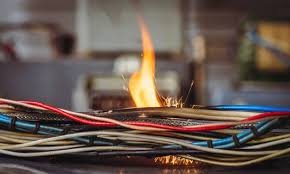As summer temperatures in Saudi Arabia soar beyond 45°C, the impact on electrical systems becomes a serious concern. One of the most common and dangerous issues during this season is overheated wiring. In both residential and commercial buildings, rising ambient temperatures, increased energy demand, and environmental factors converge to create conditions where electrical wiring becomes vulnerable to failure.
Overheated wiring isn’t just a technical issue—it poses a significant fire risk and can lead to complete power outages, equipment damage, and safety hazards for occupants. Understanding the root causes and applying the right preventive measures is essential for ensuring year-round safety.
Why Wiring Overheats in Hot Climates
Wiring systems are designed to carry a specific electrical load within a safe temperature range. When the surrounding air is already hot, it reduces the wire’s ability to cool itself, especially if it’s enclosed in conduits or sealed boxes. As electricity flows through the wires, heat is naturally generated. But in extreme weather conditions, this heat cannot dissipate properly. The result is overheating, which can degrade insulation and damage conductors.
Another common reason for overheating is overloading. During peak summer months, the usage of air conditioners, refrigerators, and industrial cooling systems increases significantly. Older buildings or systems not designed for such heavy loads may find their electrical infrastructure pushed beyond its limit, causing wires to overheat due to continuous current flow.
Dust and sand storms, which are frequent in Saudi Arabia, also contribute to the problem. When dust accumulates in electrical panels and switchgear, it acts as an insulating layer, trapping heat and making it even harder for components to stay within safe operating temperatures.
Signs of Wiring Overheating
One of the first signs of overheating is frequent tripping of circuit breakers, especially when high-power devices are in use. Lights may flicker, and outlets or switch plates may feel unusually warm to the touch. In some cases, there may be a faint burning smell or visible discoloration around outlets or fuse boxes.
These symptoms should never be ignored. Even if power is restored quickly, the underlying heat stress may be damaging the insulation or connectors inside the walls. Left untreated, it can escalate to sparking, electrical fires, or complete system failure.
How to Prevent Wiring Problems During Summer
The most effective way to reduce the risk of wiring failure is through proper planning and regular maintenance. This begins with ensuring that all wiring and components are rated for high-temperature environments. Materials like heat-resistant insulation and thermally rated circuit breakers are specifically designed to perform safely in hot climates.
Routine electrical inspections are essential, especially before the peak summer season. A qualified technician can identify worn insulation, loose connections, or circuits carrying more current than they should. Thermal imaging can also detect hotspots that are not visible to the naked eye.
Good ventilation in electrical rooms or enclosures helps dissipate heat. Dust and sand should be cleared regularly from panels and equipment to ensure adequate cooling. For new constructions or renovations, the layout of electrical systems should be designed to distribute load efficiently, avoiding concentration of high-wattage appliances on single circuits.
In addition to these technical steps, raising awareness among building occupants is also important. Avoiding the simultaneous use of multiple high-power devices and unplugging unused appliances can reduce unnecessary load during peak hours.
Long-Term Recommendations for Safer Electrical Systems
While immediate fixes are important, long-term planning ensures lasting safety. Upgrading outdated wiring systems, increasing circuit capacity, and investing in smart load management solutions can all contribute to better performance. These systems can automatically regulate energy usage, protect against surges, and provide real-time alerts for any overheating issues.
As Saudi Arabia continues to modernize its infrastructure and move toward more energy-intensive technologies, the importance of resilient and heat-tolerant electrical systems cannot be overstated. Overheated wiring is preventable—but only through consistent monitoring, proactive upgrades, and a deep understanding of how local environmental conditions impact electrical safety.
Conclusion
Saudi Arabia’s extreme summer temperatures pose a genuine threat to the safety and performance of electrical wiring. Overheating caused by increased load, poor ventilation, degraded insulation, and dust accumulation is a leading factor in many seasonal electrical failures.
By taking proactive steps—such as upgrading materials, improving ventilation, conducting seasonal inspections, and managing electrical loads effectively—homeowners and businesses can significantly reduce the risk of failure. Preparedness today ensures safety, reliability, and peace of mind throughout the hottest months of the year.







